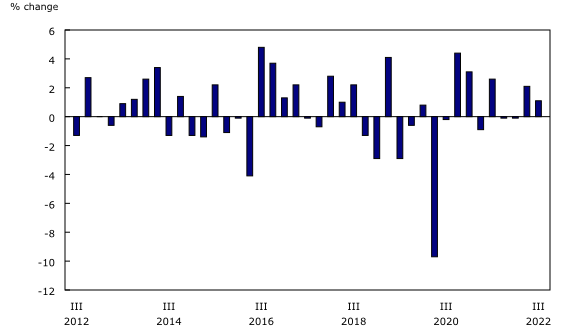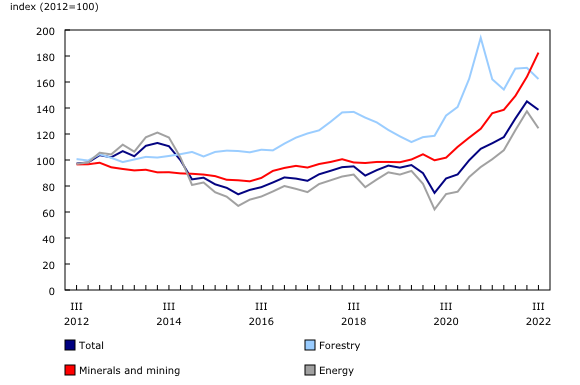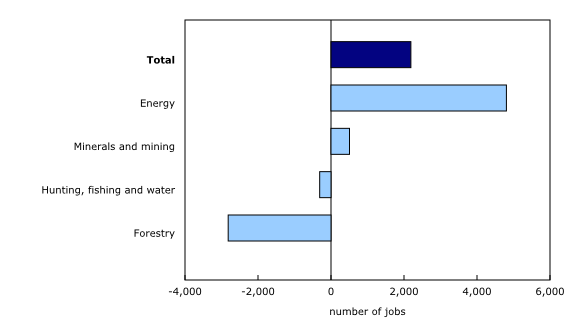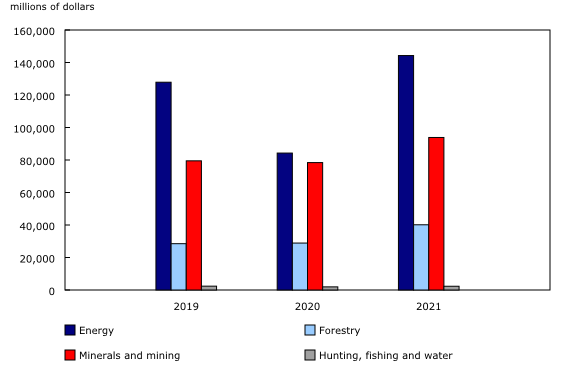Natural resource indicators, third quarter 2022
Released: 2023-01-13
Natural resources real gross domestic product on the rise
Real gross domestic product (GDP) of the natural resources sector rose 1.1% in the third quarter of 2022, after rising 2.1% in the second quarter. This outpaced the third quarter growth in economy-wide real GDP (+0.7%), as the natural resources sector benefitted from greater production of crude bitumen and potash.
The increase in real natural resource GDP in the third quarter was broad-based.
Real GDP of the energy subsector increased 1.5%, led by a surge in oil sands extraction, which was attributable to record-high crude bitumen production.
The mineral and mining subsector saw real GDP rise 0.4% in the third quarter. Non-metallic minerals rose 1.4% due to continued growth in potash mining, for which production and export volumes trended upward over the last five quarters. Metallic minerals' real GDP fell 1.6% in the third quarter, driven by decreased copper, nickel, lead and zinc ore mining.
Real GDP of the forestry subsector fell 2.6% in the third quarter, reflecting decreased demand for timber products and prices of softwood lumber. Reduced housing market activity and higher interest rates put downward pressure on lumber demand and prices.
Export volumes rise and import volumes fall
Natural resources export volumes rose 8.2% in the third quarter, following a 0.9% rise in the second quarter. Exports of energy (+12.7%) led this growth, with crude oil exports (+15.3%) showing particularly strong quarter-over-quarter growth, owing to increased international demand and lower prices.
Non-metallic minerals (+12.9%) led the growth in the minerals and mining subsector (+4.9%), the value of potash exports more than doubling since September 2021 due to sanctions on Belarus and Russia related to the war in Ukraine, increasing demand for Canadian potash. Forestry exports fell 6.5%, largely due to lower exports of lumber and other sawmill products, with both volumes and prices falling.
Hunting, fishing and water exports (-11.3%) fell in the third quarter of 2022 after rising 3.0% in the previous quarter.
Import volumes (-1.3%) were reduced due to lower energy imports (-2.5%) related to a reduction in crude oil imports (-4.4%), coinciding with maintenance at Canadian refineries. Forestry imports (-1.6%) fell, while minerals and mining imports (+0.6%) rose. Hunting, fishing and water imports fell 9.1%.
Natural resource prices and nominal gross domestic product decline
Natural resource prices (-4.5%) in the third quarter fell from peaks in the previous quarter as concerns about economic slowdowns reduced future demand expectations. This was the first natural resource price decline in nine consecutive quarters, which also influenced the valuation of natural resources wealth.
A 16.6% decrease in crude oil prices contributed to the fall in overall natural resources nominal GDP (-3.5%). This decrease was reflected in the nominal GDP of the energy subsector, which decreased 8.2%. Forestry prices decreased 5.1% on higher interest rates that reduced housing investment in Canada and the United States. In comparison, nominal GDP of the minerals and mining subsector increased 11.8%, as prices for potash and platinum increased. Expressed at an annual rate, nominal natural resources' GDP was $363 billion in the third quarter, representing 13.7% of the Canadian economy.
Employment continues to rise
Employment in the natural resources sector rose 0.3% in the third quarter, following a 1.2% increase in the second quarter. Job recovery was strongest in the energy subsector (+4,800 jobs), followed by minerals and mining (+500 jobs). Employment in the forestry (-2,800 jobs) and hunting, fishing and water (-300 jobs) subsectors decreased in the third quarter.
Downstream activities decrease
For analytical purposes, secondary and tertiary processing for the forestry and minerals and mining subsectors are identified separately. The nominal GDP of these downstream activities was $10.9 billion, a 1.4% decrease. Prices decreased 0.7% in the third quarter, following a 9.0% increase in the second quarter.
2021 annual review
This release also includes detailed annual tables for the 2021 reference year. Annual real GDP in the natural resources sector rose by 4.2% from 2020 to 2021, with widespread increases in all subsectors, compared with an economy-wide real GDP increase of 5.0% over the same period.
Real GDP of the forestry (+6.1%), mineral and mining (+6.0%) and energy (+3.4%) subsectors increased from 2020 to 2021. Natural resource prices were also up (+29.5%), contributing to a historical high in natural resource wealth.
In 2021, the natural resource sector gained 38,000 jobs, led by minerals and mining (+18,000) and forestry (+11,500), followed by energy (+6,600).
Note to readers
Data on natural resources for the third quarter of 2022 have been released along with revised data from the first quarter of 2019. Annual data tables have been released for 2021 along with revised data back to 2019. Energy services have been revised back to 2016.
The natural resource indicators provide quarterly indicators for the main aggregates in the Natural Resources Satellite Account (NRSA), namely, gross domestic product, output, exports, imports and employment. The estimates from this account are directly comparable with the estimates in the Canadian System of Macroeconomic Accounts.
Core natural resources: The NRSA defines natural resource activities as those that result in goods and services originating from naturally occurring assets used in economic activity, as well as their initial processing (primary manufacturing).
Downstream activities: Although not part of the core account, natural resources have important downstream effects on other sectors. In general, this production uses a large portion of primary manufactured products as inputs.
Employment estimates reported in this release align with the noted definitions of natural resource subsectors. Consequently, these estimates may differ from those released by the labour productivity program.
Next release
Data on natural resource indicators for the fourth quarter of 2022 will be released on March 23, 2023.
Products
For more information on energy in Canada, including production, consumption, international trade and much more, please visit the Canadian Centre for Energy Information website and follow #energynews on social media.
The Economic accounts statistics portal, accessible from the Subjects module of the Statistics Canada website, features an up-to-date portrait of national and provincial economies and their structures.
Additional information can be found in the articles "The Natural Resources Satellite Account: Feasibility study" and "The Natural Resources Satellite Account – Sources and methods," which are part of the Income and Expenditure Accounts Technical Series (13-604-M).
The Latest Developments in the Canadian Economic Accounts (13-605-X) is available.
The User Guide: Canadian System of Macroeconomic Accounts (13-606-G) is available.
The Methodological Guide: Canadian System of Macroeconomic Accounts (13-607-X) is available.
Contact information
For more information, or to enquire about the concepts, methods or data quality of this release, contact us (toll-free 1-800-263-1136; 514-283-8300; infostats@statcan.gc.ca) or Media Relations (statcan.mediahotline-ligneinfomedias.statcan@statcan.gc.ca).
- Date modified:





